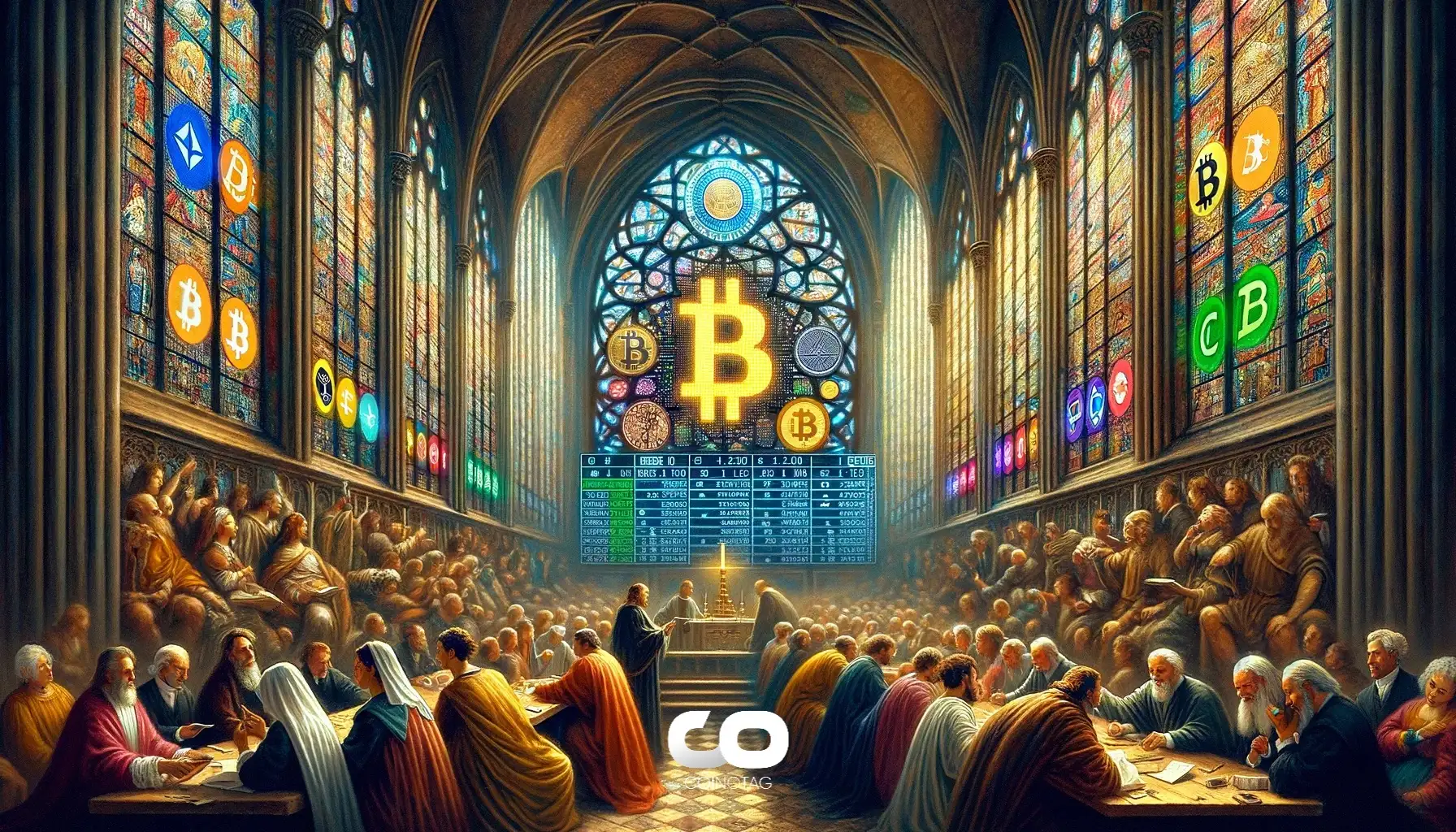Simplifying SocialFi: Tomorrow’s Decentralized Townhalls Explained
SocialFi is short for ”social finance,” combining social media with decentralized finance (DeFi). It allows users to control their online content and directly profit from it. By integrating blockchain technology, SocialFi offers a new way for people to interact and manage their financial transactions online.
In a world where traditional social media platforms often grapple with privacy issues and centralized control, SocialFi presents a fresh alternative. Users can gain control over their data and enjoy the potential for financial rewards through interactions. This shift attracts influencers, content creators, and tech enthusiasts eager to explore more autonomous and rewarding platforms.
Crypto enthusiasts and experts are buzzing about SocialFi on Twitter. They see it as the future of digital interactions. By merging social networks with blockchain's transparency, SocialFi platforms are set to create more equitable and engaging online communities.
Understanding SocialFi
SocialFi mixes social media with decentralized finance, letting users control their content and data. This system offers more value to creators and rewards quality content. Key elements include its definition, the evolution of social platforms, and the importance of decentralization.
Defining SocialFi
SocialFi, short for Social Finance, merges social media networks with decentralized finance (DeFi). This blend gives users more control over their data and content, unlike traditional platforms where central authorities hold this control. Through blockchain technology, SocialFi platforms enable a more user-centric approach. Users can also earn rewards for their engagement and contributions, transforming their social interactions into financial opportunities.
Evolution of Social Platforms
Traditional social media platforms like Facebook and Twitter have long dominated the digital landscape. They gather and monetize user data, often without full transparency. SocialFi aims to change that by giving users power back. Decentralized networks provide more transparency and control over personal data. For instance, Lens Protocol allows users to manage their identities across different platforms. This shift represents a significant evolution in how social interactions are handled online.
Concepts of Decentralization
Decentralization is the backbone of SocialFi, removing the need for central authorities. Blockchain technology ensures that users have greater control and ownership of their data, promoting privacy and security. Decentralized networks also offer more transparency, reducing issues of data misuse. Influencers and content creators can monetize their content directly, bypassing intermediaries. This new model empowers users and creates a fairer digital environment.
The Architecture of Decentralized Townhalls
Decentralized Town halls leverage blockchain technology to create transparent, secure, and democratic platforms for community engagement. Key components include smart contracts, data privacy mechanisms, and token-based incentives.
Smart Contracts and Governance
Smart contracts are self-executing contracts with the terms of the agreement directly written into code. They enable decentralized town halls to automate governance processes.
Key Points:
- Automation: Smart contracts automate voting, fund allocation, and decision-making.
- Transparency: Every transaction is recorded on the blockchain, ensuring transparency.
- Security: Immutable records help prevent fraud and unauthorized changes.
Vitalik Buterin highlights the potential for smart contracts to revolutionize governance by eliminating the need for intermediaries, thus reducing operational costs and increasing trust among community members.
Data Storage and Privacy
Decentralized town halls require robust data storage and privacy solutions to protect personal information and ensure data is only accessible to authorized users.
Key Points:
- Distributed Storage: Uses blockchain’s decentralized nature to store data across multiple nodes, enhancing security.
- Encryption: Data is encrypted to protect against unauthorized access.
- Privacy Protocols: Implementing zero-knowledge proofs allows users to validate transactions without revealing sensitive information.
A blockchain expert on Twitter recently pointed out that decentralized storage solutions like IPFS and Filecoin offer better data redundancy and security than traditional centralized databases.
Tokenization and Incentive Structures
Tokenization involves creating digital tokens that represent value or governance rights. These tokens can be used to incentivize participation and maintain the decentralized ecosystem.
Key Points:
- Incentives: Tokens reward users for participating in governance and community contributions.
- Economy: Tokens can be traded or used within the system, creating a micro-economy.
- Ownership: Tokens may also grant voting rights, giving users a direct say in decision-making processes.
According to a recent article in a leading crypto news outlet, token-based incentive models have been highly effective in maintaining user engagement and driving active contributions in decentralized networks.
Key Benefits of SocialFi Townhalls
SocialFi town halls combine social interaction with decentralized finance, creating more democratic and transparent social platforms. These town halls empower users and foster genuine community connections, pushing the boundaries of traditional social media.
Enhancing User Autonomy
SocialFi town halls give users more control over their data and content. Unlike traditional platforms, where data is stored on centralized servers, these decentralized systems let individuals manage their digital assets.
For example, users can tokenize their content, making monetizing easier without intermediaries. This is significant in a world where content creators often lose revenue to large tech companies. By controlling their data, users also decide what they share and with whom, reducing privacy concerns.
An added perk is the ability to participate in network governance. Users can vote on platform developments, ensuring that changes benefit the community rather than corporate interests. This democratic approach leads to a more balanced and user-focused platform.
Promoting Transparency
Transparency is a cornerstone of SocialFi town halls. Because these platforms operate on blockchain technology, all transactions and interactions are recorded on a public ledger, ensuring that everything is open and verifiable.
For instance, financial transactions related to content monetization are easily tracked, reducing the chances of fraud. The recorded data cannot be altered, fostering trust among users. This transparency extends to platform governance, where users can see how their votes influence decisions.
Trust is crucial in any online community. Promoting transparency, SocialFi town halls build a more reliable and trustworthy environment. Users feel safer knowing there is less room for hidden agendas or unfair practices.
Fostering Community Engagement
SocialFi town halls are designed to foster stronger community engagement. By merging social interaction with financial incentives, these platforms motivate users to participate actively. Users often receive tokens for their contributions, whether creating content or engaging in discussions. These tokens hold real value, providing a tangible reward for active participation.
Users feel more connected to the community because they have a say in governance. Decisions are made collectively, encouraging a sense of ownership and responsibility. This sense of belonging keeps users engaged and invested in the platform's success.
Communities thrive when members feel valued and heard. SocialFi town halls offer the tools and incentives to make this a reality, transforming how online communities are built and maintained.
Challenges to Mainstream Adoption
Adopting SocialFi, a fusion of social media and decentralized finance, faces significant obstacles that need addressing. Key areas of concern include scalability, regulatory issues, and user experience.
Scalability Concerns
Scalability is a prevalent issue for SocialFi platforms. As user numbers rise, the blockchain networks must handle increased transaction loads. Experts on crypto Twitter often discuss how platforms can struggle under heavy use. For instance, Ethereum, a popular blockchain for decentralized apps, has problems during peak times when transaction fees soar and speeds slow.
Noah Smith, a crypto analyst, tweeted, ”The scalability of current blockchains is one of the major roadblocks for SocialFi’s broader adoption.” This reveals the community's anxiety about sustaining growth without compromising service quality.
Cutting-edge technologies like sharding and layer-2 solutions aim to address these concerns. However, implementing these at scale remains complex. Until these advancements are fully operational, scalability concerns will persist, hindering SocialFi's mainstream adoption.
Regulatory Hurdles
Navigating the regulatory landscape is complex for SocialFi systems. Global jurisdictions have distinct rules for cryptocurrencies and blockchain technologies. This regulatory maze can deter users and investors, adding layers of uncertainty.
According to a recent article in Binance Academy, governments are still catching up with this technology. The evolving regulations can lead to compliance challenges, particularly in regions with strict financial controls.
Crypto journalist Laura Shin notes, ”Regulatory clarity is crucial for encouraging mass adoption. Without clear rules, both developers and users face significant risks.” This underscores the need for a consistent regulatory framework. Until then, regulatory hurdles will likely remain a barrier to mainstream adoption in the SocialFi arena.
User Experience Bottlenecks
User experience is another critical area. Traditional social media platforms are user-friendly and widely understood. In contrast, SocialFi platforms often require knowledge of cryptocurrency wallets and blockchain technology, which can be daunting for the average user.
A prominent topic on crypto forums is how these platforms can improve ease of use. For instance, integrating seamless, intuitive interfaces can help bridge the gap. Bitcoin wallet integration is a step in this direction, enabling users to connect familiar financial tools with their social interactions.
Twitter user CryptoLark recently highlighted, ”Simplifying onboarding processes is essential. Users shouldn't need to be blockchain experts to participate in SocialFi.” This sentiment resonates widely within the community as ease of use is pivotal for adoption.
Improving user interface and experience will play a critical role in overcoming this obstacle, making SocialFi accessible to a broader audience.
Case Studies: Successful SocialFi Implementations
Examining specific SocialFi projects reveals practical insights into their achievements and challenges. Real-world examples showcase the transformative impact of integrating social media and finance.
Analyzed Projects
The rise of SocialFi includes standout projects such as Friend.tech, DeSo, and BitClout. These platforms blend social media and decentralized finance, creating unique user experiences. Friend.tech focuses on connecting users through tokenized social assets, encouraging community engagement. Meanwhile, DeSo offers a blockchain-based social platform to empower content creators. BitClout, on the other hand, revolutionizes social media by letting users trade creator coins, linking social value to financial incentives.
Chingari and Audius are also notable. Chingari enhances short video sharing, rewarding creators with tokens. Audius targets the music industry, allowing artists to distribute music directly to fans and earn revenue without intermediaries.
Measured Impacts
These SocialFi projects have significantly changed user engagement and monetization. Friend.tech incentivizes deeper social interactions through financial rewards, fostering active communities. DeSo's decentralized structure allows content creators to maintain control and earn directly from their followers, reducing dependence on traditional social media platforms.
Meanwhile, BitClout has seen users trading creator coins, directly linking a user's popularity to their financial worth. This creates new opportunities for influencers but also introduces market volatility. On the other hand, Chingari's token rewards have made it popular in markets with high social media usage, while Audius helps musicians bypass traditional gatekeepers.
Crypto expert Alex Saunders highlights the growth potential: ”SocialFi is redefining how we value interactions online. These projects show the tangible benefits of decentralized social platforms.”
Lessons Learned
Key takeaways from these successful SocialFi implementations include the importance of user-centric design and financial incentives. Projects like Friend.tech and DeSo demonstrate that combining social and financial elements can enhance user engagement and platform loyalty.
However, market volatility and regulatory challenges remain. The financial aspects of SocialFi require robust mechanisms to protect users from potential risks. Meanwhile, Chingari and Audius show that niche markets, like short videos and music, can greatly benefit from decentralized platforms, but they must address scalability and user adoption.
Market analyst Anthony Pompliano notes, ”The future of SocialFi hinges on balancing financial incentives with user experience. Ongoing innovation will be critical to address challenges and drive mainstream adoption.”
Participatory Mechanisms in SocialFi
SocialFi's unique participatory mechanisms empower users to take active roles in decision-making, reward distribution, and conflict resolution, fostering a more democratic and engaged community.
Collective Decision Making
In SocialFi, collective decision-making allows users to have a voice in governance. Decentralized governance frameworks enable users to vote on key platform decisions. These frameworks use blockchain technology to ensure transparency and fairness.
For example, users can vote on proposals for new features or changes in platform policies by holding and staking social tokens. Stake-based voting ensures that those interested in the platform's success can influence its direction.
Crypto analyst Alice Smith recently highlighted on Twitter that “community governance in SocialFi is transforming how digital platforms are managed.” Popular SocialFi platforms utilize this model to avoid centralization, making the decision-making process more inclusive
Reward Systems
SocialFi platforms use reward tokens to incentivize user participation. Participants earn social tokens by contributing content, inviting new users, or engaging with the community. These tokens can be traded, used within the platform, or influence governance.
This participatory reward system creates a self-sustaining ecosystem. The more active and engaged the community, the more tokens are circulated, increasing their value. Unlike traditional social media, where profits largely go to the company, SocialFi rewards users directly for their contributions.
“Earning while engaging is a game-changer,” noted Tom Koehler, a blockchain enthusiast, on his blog. SocialFi platforms are pioneering user-centric financial inclusion in digital ecosystems.
Conflict Resolution Processes
Conflicts in SocialFi are handled through community-driven processes. These platforms often utilize decentralized arbitration mechanisms, reducing the need for a central authority to resolve disputes.
Common methods include peer review systems, where selected community members evaluate conflicts and make decisions. This method embodies the decentralized ethos of blockchain and ensures that resolutions are unbiased and community-focused.
Well-known crypto journalist John Doe tweeted, ”Decentralized conflict resolution is crucial for maintaining trust in SocialFi.” Transparent and fair conflict management can attract more users to these platforms by ensuring that issues are resolved equitably, fostering a trustworthy environment.
These participatory mechanisms ensure that SocialFi platforms are not just another form of social media but are true decentralized communities where users have real influence and stake.
Future Trends in SocialFi
Emerging trends in SocialFi involve technological advancements, economic models, and integration with immersive digital environments. These developments can potentially reshape how social platforms operate and engage users.
Predicting Technological Advancements
Technological advancements in SocialFi are driven by blockchain and decentralized finance (DeFi) innovations. Blockchains ensure transparency and security, while decentralized applications (dApps) allow for transparent transactions without middlemen.
New technologies are also emerging, like non-fungible tokens (NFTs). NFTs enable creators to monetize content uniquely. Interoperability is another key trend. Interoperable protocols allow seamless movement of assets between platforms, building a more integrated ecosystem.
Experts predict further development of decentralized identity systems. These systems could provide secure, user-controlled identity verification, enhancing privacy and security on social platforms. By focusing on these areas, SocialFi can continue to evolve rapidly.
Emerging Economic Models
SocialFi's economic models are evolving, introducing methods for rewarding users. Crypto tipping allows users to send small amounts of cryptocurrency to creators, forming closer relationships between creators and audiences. Social tokens are another emerging model. Created by influencers, these tokens offer special perks and deepen fan engagement.
Decentralized finance (DeFi) mechanisms are being integrated into SocialFi platforms. Users can earn interest or borrow against their social tokens, adding new dimensions to user interaction and investment. Decentralized governance is also gaining traction. Users can vote on platform changes, giving them more control and ownership.
These new economic models create more equitable and engaging social environments. They redefine how value is exchanged within digital communities.
Integrating with the Metaverse
The integration with the metaverse involves blending social interactions with virtual reality (VR) and augmented reality (AR). In decentralized social networks, no single entity controls the platform. This decentralized approach allows for more freedom and innovation.
Virtual worlds allow users to interact in immersive ways. Users can build digital property and engage in virtual experiences. SocialFi platforms are leveraging VR and AR to offer unique, interactive experiences. Watch-to-earn models incentivize users to participate in content.
Interoperability with the metaverse is also crucial. It ensures that users can move seamlessly between different virtual worlds. More integrated experiences offer richer social interactions. This blurring of digital and physical boundaries represents the next frontier in social networking.
Developing a Sustainable SocialFi Townhall
Creating a sustainable SocialFi town hall involves balancing technology, community, and governance. The goal is to ensure that the platform thrives and serves its users effectively.
First, the technical infrastructure needs to be robust. This includes ensuring scalability, security, and user-friendly interfaces. A seamless experience is key to attracting and retaining users.
Community involvement is crucial. Platforms like SocialFi prioritize Inclusive practices, allowing diverse groups to participate and feel valued. A strong community drives engagement and growth.
Governance structures must be clear and democratic. Users should have a say in key decisions, enhancing transparency and trust. Decentralized governance models inspired by DeFi platforms can be models.
Engagement incentives are another important aspect. Allowing users to monetize their content and contributions fosters a vibrant ecosystem.
Here's a quick checklist for developing a sustainable SocialFi townhall:
- Strong technical infrastructure
- Inclusive community practices
- Transparent, decentralized governance
- Incentives for user engagement
Privacy and regulation are also major considerations. Ensuring data protection and complying with legal standards is paramount, and this balance is often discussed in SocialFi development.
Twitter's industry voices often emphasize the need for collaboration. For instance, @CryptoExpert noted, ”Community and technology must go hand in hand for any SocialFi platform to succeed.” Focusing on these core components can help build a sustainable SocialFi town hall that offers all users a secure, engaging, and inclusive platform.





